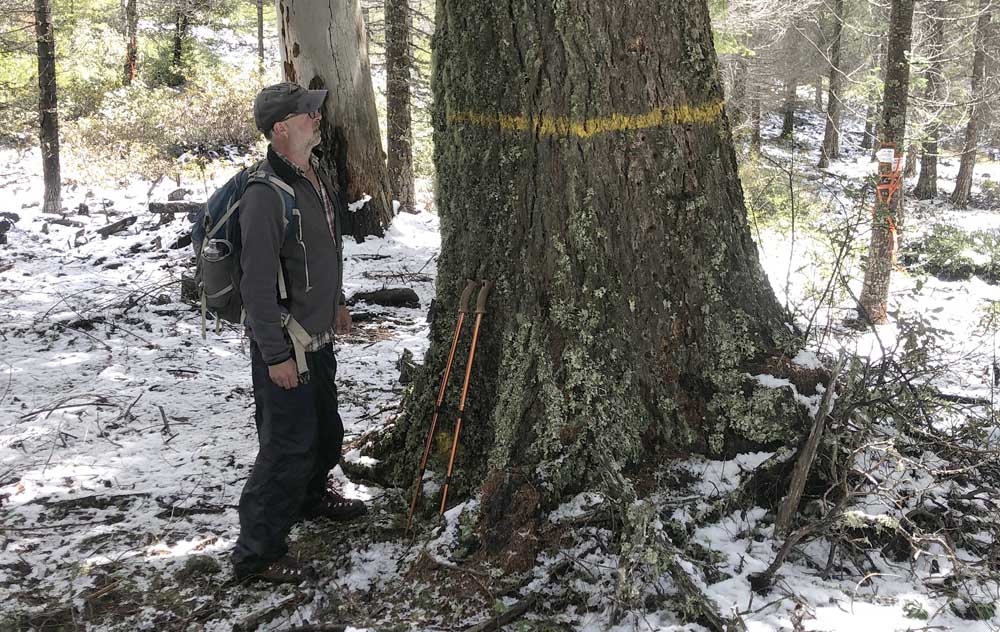BLM puts off logging plans, wildfire reduction work after legal challenge
Published 7:15 am Wednesday, June 7, 2023

- George Sexton, conservation director at the Klamath-Siskiyou Wildlands Center in Ashland, stands next to a tree he said was originally marked to be saved as a wildlife tree, but later slated to be logged to make way for a road as part of the Late Mungers project near Williams. The project, proposed by the U.S. Bureau of Land Management, is an effort to reduce wildfire danger and improve forest health, but a federal judge last week ruled against the agency's plan to log large trees in protected reserves.
A legal challenge to the commercial logging of 830 acres of old-growth trees on federal forest land near Williams and Murphy has prompted the U.S. Bureau of Land Management to delay two timber sales there and to put off related fuels-reduction work aimed at reducing fire danger on 7,500 nearby acres.
One of the timber sales, known as Penn Butte, was scheduled to take place in late May, while a second sale, Late Mungers, was scheduled for July, but both have been put off until Sept. 14 due to the litigation, according to BLM spokesman Kyle Sullivan. He said the fuels-reduction work also has been put on hold.
“We can’t move forward with anything because it’s under litigation,” Sullivan said Tuesday.
The Klamath-Siskiyou Wildlands Center of Ashland and three other environmental organizations filed suit April 10 in U.S. District Court in Medford challenging the timber sales, saying environmental assessments were lacking.
The logging is the first proposed under a new districtwide vegetation-management plan adopted last year by the agency for its Medford District. It’s that plan, and the logging it authorizes, that’s being challenged. The fuels-reduction work would follow the plan, too.
While the lawsuit specifically targets the timber sales and takes pains to not challenge the fuels-reduction work, the fuels work has become collateral damage at a time when wildfire risk has been increased by drought, disease, insects, densely packed second-growth trees and decades of fire suppression that has left brush and forest fuels intact to burn.
George Sexton, conservation director for KS Wild, said the BLM “can and should” go ahead with its fuels-reduction work while awaiting the outcome of the litigation.
“Do the small-diameter thinning,” Sexton said Monday in a telephone interview. “Do the prescribed burning.”
“The only thing people are trying to stop is the old-growth logging.”
Small-diameter logging is a reference to small trees, while prescribed burning refers to the use of fire close to the ground to mimic natural processes. When trees exceeding 8 inches in diameter are harvested, that’s considered commercial logging. Old-growth logging refers to large trees. The two timber sales are in an old-growth forest, in a so-called late successional reserve.
The BLM is proposing to log trees up to 36 inches in diameter with the stipulation that, if any trees larger than 36 inches are felled for safety or operational reasons, they must stay on the property, according to Sullivan, the BLM spokesman.
Asked about the possibility of the agency going ahead with the fuels-reduction work on 7,500 acres while pausing the timber sales on the 830 acres, Sullivan said the logging and fuels are linked.
“It wouldn’t help if we removed one of these tools,” he said. “They’re complementary.”
“Hire a carpenter and tell them you can’t use a hammer,” he said. “We need the full package to create a resilient forest. Commercial timber removal is an integral component of effective forest restoration.”
The logging and fuels work, known collectively as the Late Mungers Integrated Vegetation Management Project, would take place over 40 tracts in the mountains between Williams and Murphy. The logging would focus on ridgetops and near roads, according to Sullivan. The project area includes lands near Spencer Creek Road, Powell Creek Road and Mungers Creek Road, as well as others. Spencer, Powell and Mungers creeks are part of drainages that flow into the Applegate River.
The intention of the project is to increase forest health and lessen risk of wildfire, but those contentions are challenged by the plaintiffs, which include the Soda Mountain Wilderness Council of Ashland, Cascadia Wildlands of Eugene and Oregon Wild of Portland.
They contend that an environmental assessment completed last year and applied across BLM’s Medford District doesn’t take a close enough look at the Mungers project. The assessment, integral to the agency’s districtwide vegetation management plan, is an effort to speed timber sales and fuels-reduction work across the district, without the need to undertake additional environmental assessments.
The districtwide plan allows “gap creation” logging that Sexton likened to Swiss cheese, with the holes representing logged areas up to 2 acres in size. The plan also allows “open seral” logging, which he said would reduce the forest canopy to as little as 30%.
Sullivan said gap logging was an intent to replicate nature, such as when a ridgetop lightning strike causes limited damage or sparks a small fire that opens a gap in the forest canopy. He also said that open seral logging was an attempt by the agency to reduce competition between trees so that large trees grow larger.
The goal, he said, was “to protect and promote the large old trees and create the next generation of large, old trees.”
Also opposing the Mungers project, though not a party to the lawsuit, is the Williams Community Forest Project, which has protested at the agency’s Medford offices and raised $21,000 to fight the BLM’s plans. Cheryl Bruner, secretary for the Williams group, welcomed the timber sale delay.
“You can imagine, we were extremely happy,” she said in a telephone interview. “I hope the litigation works.”
Bruner hopes that the BLM cancels the whole project, including its fuels-reduction and thinning work. She said trees need other trees, they protect water supply and they help offset climate change. The agency should leave old-growth forests alone, she said.
“We want them to stay out completely,” she said. “I feel they need to stay out of there.”
In a related matter, two other BLM projects that contain no commercial logging are proceeding under the district’s vegetation management plan. They include fuels work on 1,294 acres near the Table Rocks, and on 1,904 acres near Butte Falls. Sexton said he was aware of the projects and that his organization wasn’t challenging them.






